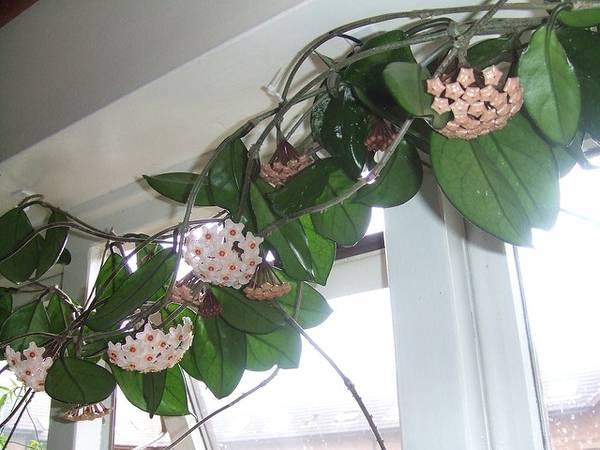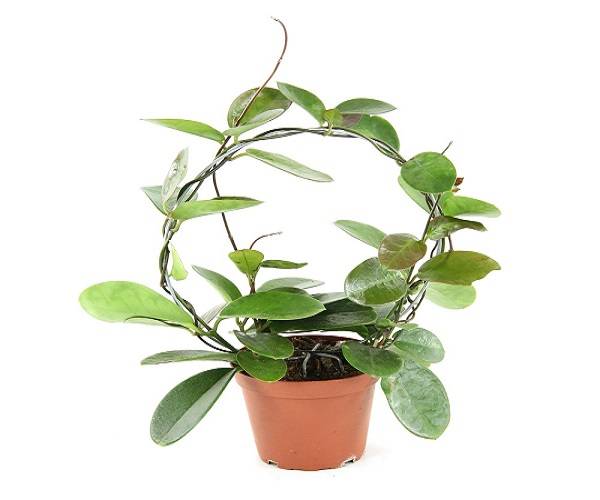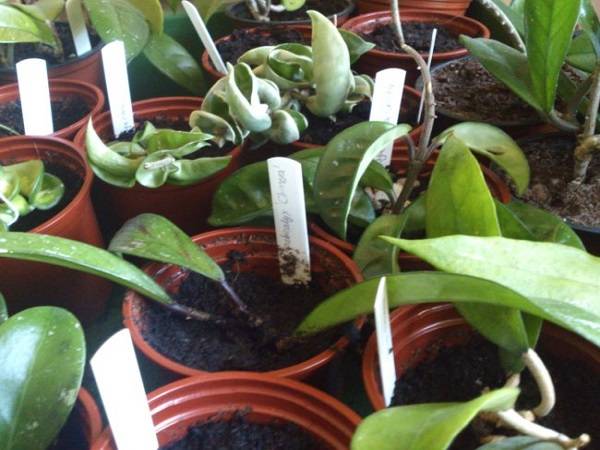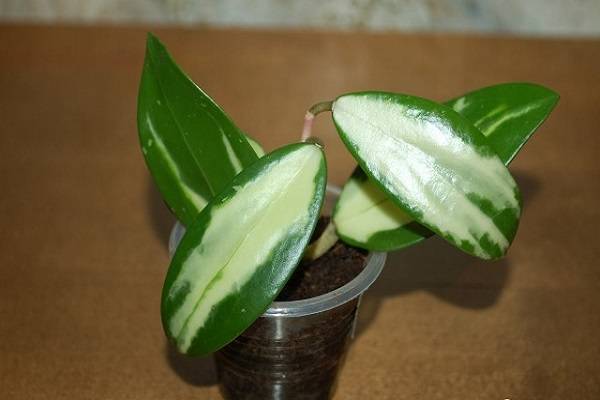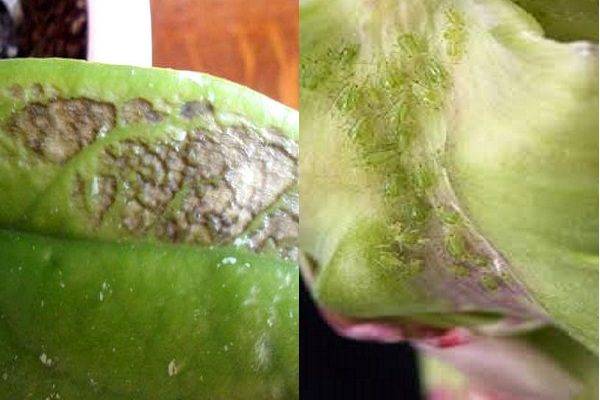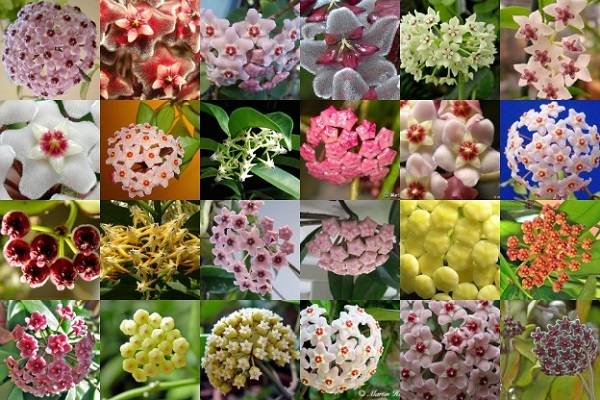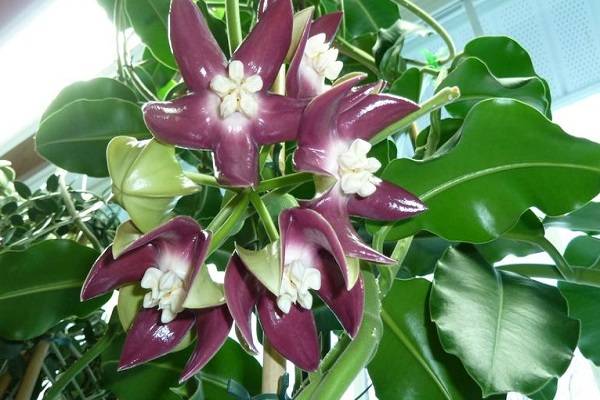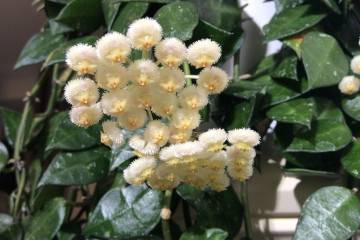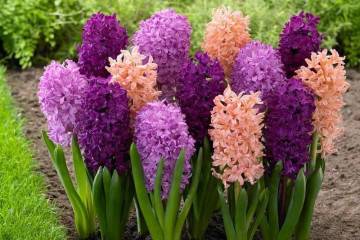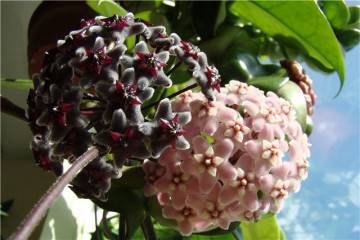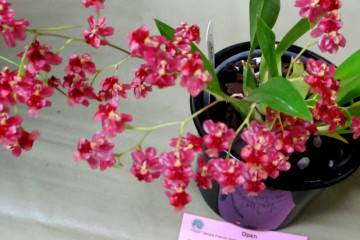Hoya - home care
Content:
A perennial plant with fleshy shiny leaves is called hoya. In nature, the branches of the plant grow up to 10 m. Indoor conditions do not allow the shoots of the plant to reach such sizes.
The plant is attractive not only for the look of shiny leaves and honey droplets on colorful flowers, but also for its delicate smell. It helps the hoya plant to bloom luxuriantly at home, according to the rules.
What does hoya look like - wax ivy
There are three species groups of a flower: bush, hanging (ampelous) and long vines. Bushes grow up to 1 m tall, amenable to shearing, crown formation. The ampelous species hangs down in green pagons with flower umbrellas, reaches a length of 80 cm. The branches of the liana grow flexible up to 3-4 m. The first to appear are thin brown pagons, over time they turn green, petiolate fleshy leaves appear along the stem.
The leaves are thick, reminiscent of representatives of the Succulent family, up to 8 cm long and up to 5 cm wide. They are oval in rich green color with a pointed end. The surface of young foliage is shiny, with age, the shine dims. The sheets are green in color with various additions: specks, stripes, veins, color transitions along the edges.
Indoor ivy belongs to the Kutrovy family (dicotyledonous), the Lastovnevy subfamily. It is named after the English gardener T. Hoy, who worked in the tropical greenhouse of the Duke of Northumberland.
Hoya habitat - South Asia, Polynesia, western Australia, India, Madagascar. The plant grows in rare tropical forests, tree trunks serve as a support for it.
Hoya: home care
Hoya is grown in greenhouses or on the windowsills of the house as an indoor flower. It is better to keep a bush or ampelous view in an apartment. Only in the greenhouse for the liana hoya are natural living conditions created, which does not stop flowering all year round.
Temperature
Tropical hoya is heat demanding. A comfortable temperature for her is 25-30 ° C, but the flower is good at 18 ° C. Cold air, temperature 6 ° C will ruin him. Yellowing and shedding of foliage indicate hypothermia.
Lighting
Hoya is a waxy ivy that loves light, grows and blooms on a sunny window, but requires shading on hot summer days. Feels great in the fresh air in partial shade, but over the course of a week it needs to be gradually accustomed to new conditions, spray the leaves in the morning and evening. In the fall comes a dormant period, you need to reduce watering and spraying.
Watering
Indoor tropical ivy loves abundant watering, especially in summer. It is worth watering with filtered warm water on the ground. When the water seeps into the sump, it is drained. The plant is watered in the summer after two days, the soil should dry out before that, in the winter as the soil dries out.
Spraying
Indoor ivy loves a humid environment, so in the summer it is worth spraying it with warm water with a misty spray. In winter, rubbing the leaves with a damp sponge is enough. If it is hot in the apartment in winter, the plant is sprayed in the bathroom under the shower.
The fleshy hoya can be taken outside under the warm summer rain. Then the leaves should be shaken off excess moisture.
Humidity
Moisture-loving hoya does not tolerate waterlogging of the soil. This provokes decay of the roots, which leads to the death of the plant. Drying out of the earthen coma will entail shedding of flower umbrellas, leaves, and the death of branches.
Priming
The soil is selected porous. A young seedling is planted in a container with soil for anthuriums; for an adult plant, orchid soil is used with the addition of birch charcoal, coarse parts of peat, soil for succulents. Drainage is mandatory.
The flower is transplanted after 3 years, completely replacing the soil. In large containers, replace the top layer by 5 cm.
Top dressing
Hoya needs to be fed every month with osmokot fertilizer, sprayed twice with a solution of liquid humus. The latest composition of balanced micronutrients. Universal fertilizers are also used, the concentration of the solution is halved.
Crown formation
For a hoya bush plant, care includes pinching and crown formation. Flexible liana lends itself well to cutting. After the appearance of 4 leaves, a pinch is done, new shoots will grow from the sinuses. For props, wooden ladders, lattices, oval wire structures are used. Shoots that are too long are shortened to stimulate the formation of peduncles.
When and how it blooms
If the care of the hoya flower is properly organized, the umbrellas begin to bloom in the spring. Each star lasts 20 days, then fades and crumbles. Do not remove the umbrellas, new flowers will open in the same place. Lush bloom requires a lot of light, which is available on the east window. On the south side, bright rays will burn the leaves, so shading will be required, which affects abundant flowering.
The bush throws out a peduncle in the first year of growth under comfortable conditions. From December to February, conditions are created for a dormant period: you need to lower the air temperature to 15 ° C, reduce watering to a minimum.
All types of hoya form peduncles on separate legs in the form of umbrellas. An asterisk with a diameter of 1.5 cm consists of 5 petals with pointed noses. All peduncles are small in size. Only the flowers of the Imperial variety have a large diameter of 7-8 cm. In the center, there is the same five-star shape of thick accrete stamens. The colors are varied: from white to red, including two-tone. The stamens of the hoya flower form a nectar droplet. Hoya blooms in waves - from April to October.
The shape of the flower is mainly convex, consists of two layers: the lower one is a five-pointed thickened asterisk, the upper crown of fused anthers. There are forms where the petals bend towards the peduncle stem, and the anthers bulge outward. Some types of hoya form pointed stars, in which the anther stands on a stem in the center of the flower, and the petals are bent towards the peduncle. For example, Hoya Undulata has a flower in the form of a cap, inside which is an anther star, while Hoya Obscura has a crown of anthers placed on a fluffy ball of thin petals.
Flowering stops in the fall before the dormant period, in the greenhouse it occurs all year round, since there is an opportunity to create natural conditions. If the care for the hoya plant is correctly formulated, it blooms for a long time and abundantly.
Pruning
Pruning of the plant is carried out for abundant flowering, long pagons are shortened.They are cut to 1/3 of the length of 1 cm above the sheet. Shrub species are formed to give a compact crown shape. Ampel varieties require shortening of vines for lush flowering.
How does it multiply
The indoor flower hoya propagates, like all plants, by seeds, layering, cuttings, leaves.
Seeds
Seeds appear after flowering, if you resort to artificial pollination, but this is difficult, therefore this type of reproduction is not popular among flower growers. The method is practiced in greenhouses.
Seeds are sown only fresh, since after 6 months they lose their germination. A mixture of sphagnum moss with universal soil 1: 1 is used for sowing. The container with the mixture is placed in a greenhouse, where a humid regime is observed. After a week, the seeds germinate. Within three months, the sprout grows foliage. Every day the sprout is ventilated, starting from 5 minutes, gradually adding time to 12 hours.
Layers
The easiest way is rooting by layers. Wet soil is collected in a bowl, which is placed next to the flower pot. You need to put the lower branch in it and sprinkle it with soil. A month later, roots appear under the knot, this is a sign that you can cut off a branch from the mother bush. After a year, the young shoot is transferred into a container with a larger volume.
Cuttings
This way of rooting takes longer. Earth for cacti is poured into a transparent small glass with drainage, moistened. The stalk is cut 1 cm below the node, dipped in the root former, planted to the internode. Roots under a transparent plastic glass for 45 days, ventilated and moisturized every day. When the cups are filled with roots, the ivy is transplanted into a larger pot.
Sheet
Not all species reproduce by the sheet method. The leg of the leaf is placed in the soil to the base, a greenhouse is made.
Transfer
Young wax ivy is transplanted every year, and an adult is transplanted after 3-4 years. The transplant is carried out in the spring, the container is needed more by 2 cm in diameter.
Possible growing problems
The main problem with growing is overflow, after which fungal diseases appear. With a lack of light, young ivy will not bloom, and excess sun will manifest itself as burns on the leaf blades. Hoya is a plant that loves a tight container for the root system, this stimulates the formation of flower buds.
Pests
On hot summer days, indoor ivy, like all plants, requires protection from pests: aphids, spider mites, and scale insects. From them, the plant is treated with Actellik, and for prevention, thick leaves are wiped with an aqueous soapy infusion of wormwood.
Other problems
Flower umbrellas can crumble when moving to another place, from the cold, drying out of the earthen coma. The lack of fertilizer has a depressing effect on the growth and development of the nodes. Leaf plates turn yellow and crumble when the temperature rises in hot summer.
Views
Hoya's other name is “porcelain flower” for its beauty and grace. Indoor ivy has more than 40 varieties, and there are even more varieties. Florists grow some of them, which are described below.
Hoya multiflora is a compact bush. Young stems are dense, leaves are thin, curved. The inflorescences look like snow arrows with needle-like petals.
The Australis variety is a waxy Hoya that lives in the rainforests of Indonesia, Australia. The leaves have a varied shape from oval to pointed with light veins. Young branches in the sun have a cherry coloring. Grows in the sand next to stones.
Hoya Bella (Lanceolata Bella) grows on the shores of India, Thailand.The root system grows poorly, so the variety is planted in a group in a low pot, barely covering the roots. Hoya Bella has a white color, flowers inside with a purple crown.
Byakensis is found in South China, India. This variety is striking in the variety of coloring of rounded sheets that have light blotches. The coloring of the stars is yellow with pink crowns inside.
Hoya Tricolor is a plant that changes color at different flowering periods. Hoya Tricolor releases cherry buds on an umbrella, which, when blooming, change color to pale pink. When fully expanded, the Tricolor hoya is cream-colored with a red crown.
Hoya Vayeti is a Filipino bushy species with red fluffy pom-poms of flowers on which a star of stamens rises. It smells like natural flower honey.
The Villoz variety is native to Vietnam. It is distinguished by large shiny oblong leaves, on which dark veins are visible. Fluffy glomeruli with yellow crowns emit the finest aroma.
Globulosis is a species found in the forests of Laos, Cambodia. The leaves are large, light green, the veins are dark, the edges are wavy. Peduncles form a round ball with white and yellow flowers. The variety is afraid of direct sunlight, the plates get burns.
Hoya Gracilis is a Filipino pink beauty who loves partial shade, does not tolerate overflow.
Imperialis grows on the island of Malacca. This hoya has the largest flowers: the petals are lilac, the center is expressively white. The aroma intensifies in the evening. Prefers lime soil, does not tolerate excess moisture, requires backlighting in winter.
Incrassata is a hoya species found in the Taubas province of Manila. Each flower has a brown border around the edge, sand coloring and a bright yellow center.
Campanulat lives in the tropics of Indonesia. On long vines there are hats of lilac water lilies, inside there is a pink star. Leaves are narrow, oblong.
The Caudata variety is native to southern Thailand. Oval leaf blades grow up to 14 cm in length. The flower basket covered with long eyelashes is white at the edges and red on the inside.
Hoya Queen is a compact bush with a variety of foliage colors, which changes depending on the place of detention (it can be rich green or light green with yellow blotches).
Kentiana is found in Burma, Philippines. Leaves are thin, more than 10 cm long. In apartments, it is kept as an ampelous species. The bright red umbrellas exude a honey scent.
Kerry is from Asia. The leaf blade has the shape of a heart, which is why it is called "happy heart".
The leaf blades are variegated, the flowers themselves have different colors from white to red.
Hoya Compacta is an inhabitant of South China. A compact bush with wavy leaves is grown in one place, as it does not tolerate rearrangement. The pink shade of flower umbrellas delights the eye for a long time. The flower smells like honey with coffee.
Curtisi is a snow hoya, a miniature type of hoya from New Guinea. White inflorescences with pink centers are three times as many leaves. Used as an ampelous view.
Crimson has leaf plates and flowers of variegated colors: green with sandy blotches, pink with a white border.
Lisa, a snow-white "inhabitant" of Australia, has a different name - South Hoya. Young shoots are red, leaf blades are sandy in the center, dark green along the edges.
Linearisa is an ampelous species that comes from China, Nepal. A wide root system requires a large capacity for each transplant. The leaves are long, thin, 6-meter branches hanging beautifully from the pots. A flower that smells of vanilla disappears after flowering.
The lobby is originally from Thailand, Burma. The variety has purple flowers with a pink basket.
Hoya Locky was brought from Vietnam. There are only 50 species of species that are protected by law. It dwells as an aerial species in tall trees.Smells like chocolate, especially in the evening. The coloring is pale white, the flower is compact and pointed.
Macrophylla found on the Java island. Sharp white petals are bent towards the peduncle, the crown is cherry-colored pubescent. The strong vine is covered with large green leaves with a sandy strip in the center.
Hoya Matilda is a snow-white beauty with rounded leaves that can change color, complementing the green color with sandy blotches.
Meliflois is a Filipino bright star that blooms in June. She has brown nectar. Differs in the rapid growth of branches.
Minibel is a variety obtained by crossing two species. Named after the biologist's wife. Pleasing to the eye with a bright pink color. The variety is unpretentious and shade-tolerant.
Hoya Obscura found in the Philippines mountains. Fluffy pom-poms of yellow inflorescences cover the entire vine.
Pahiklada is a white snowflake with a creamy middle from Burma.
Polineira is from the Himalayas. Grows in forests where there are frequent monsoon showers. The variegated color of the leaves is not inferior in beauty to white flowers with a red core.
Signs and superstitions about the hoya flower: why you can't grow at home
Signs and superstitions about hoya are very different: positive and negative. Liana is said to be an energy vampire that brings negative emotions and quarrels into the house. It is believed that hoya is a wax ivy that brings misfortune, survives from the house of all residents, except for the hostess. And the other side claims that the consent came to the house along with the young seedling. The indoor ivy placed in the bedroom brought, on the contrary, harmony.
Scientists have conducted research and proved that hoya does not have any effect on human health. Only in the bedroom where the allergic person is resting, you should not put a pot with a strong smelling look.
Despite all the prejudices, hoya blooms and smells very impressively. All its types decorate many apartments. The care of the hoya plant does not provide much trouble. Compliance with simple rules will help you grow a compact bush that will bloom for a very long time.
Video
